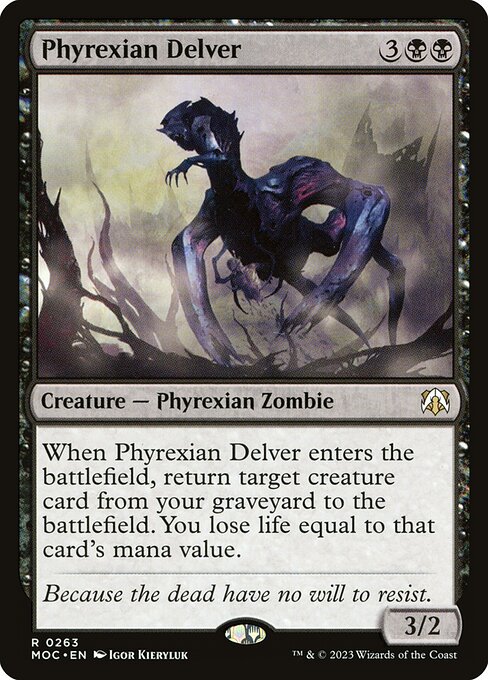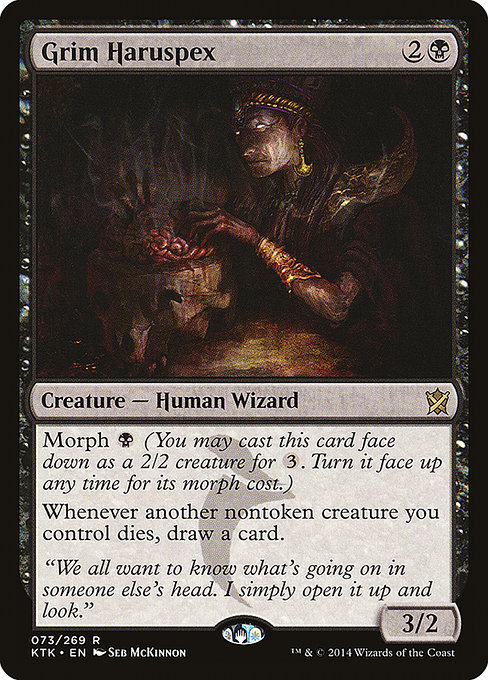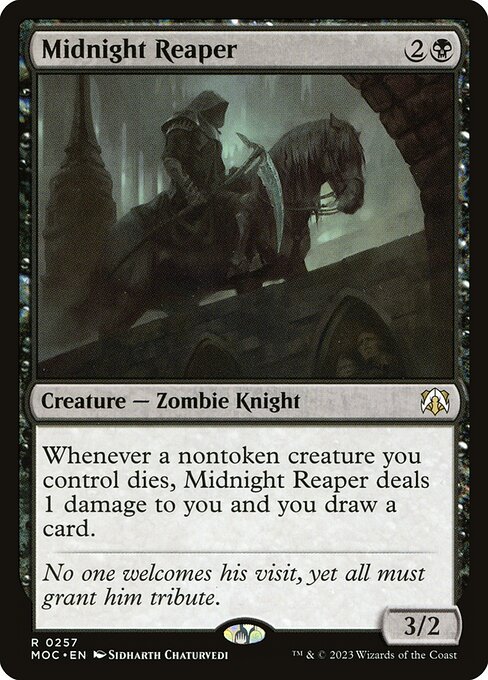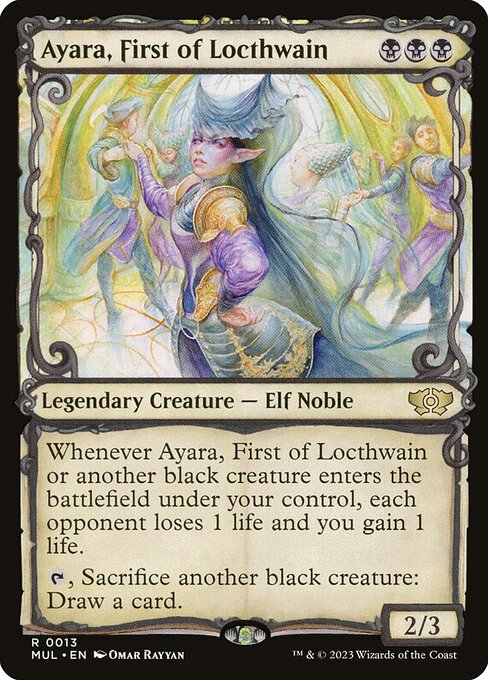Let’s start by asking: “What does Black do?”

When you ask “What does Black do?” the most honest answer might be another question: “What does Black NOT do?“. If you want to break the usual rules of Magic, Black is often the color that can do it. Where other colors might have clearly defined strengths and weaknesses, Black blurs those lines. It’s the color of versatility and cunning.
The Cost of Breaking the Color Pie
Black probably is the most flexible color in all of Magic: The Gathering. There used to be limits to what it could do in the past, but at some point they leaned into Black’s most iconic feature: it can do anything, for a cost. This is what sets it apart from other colors that might have more rigid, straightforward strengths. In a way, Black is the ultimate toolbox: nearly anything you want to do in Magic, Black can do it.
This type of flexibility has seeped into all 5 colors of Magic in one way or another over time, however in the case of Black this is balanced by the fact that a cost (besides mana) is often required to break the usual Color Pie. It is this balancing between cost and reward that makes playing Black so fulfilling (as well as ruining the game for other people, let’s be honest).
It may seem counterintuitive to sometimes pay steep prices but this is what Black revels itself in. Health, hand, creatures, everything and anything in the game is a resource for a Black mage, so don’t be afraid to test the boundaries. That’s why it is so challenging and fun to play with this color!
This cost-reward system balances Black’s flexibility, keeping the power in check while rewarding smart, risk-aware play. That’s why it has access to so many effects that would otherwise break the rules. Here are some examples:
- Destroying artifacts and enchantments — Withering Torment | Feed the Swarm
- Drawing cards at a steep life cost — Necropotence | Phyrexian Arena
- Reanimation — Reanimate | Living End
- Forced discard — Thoughtseize | Hymn to Tourach
For the sake of being concise we will only explore three archetypes, which arguably are the most iconic for the color. Any of them is strong enough to win and make you a target at your table.
Archetype 1: Reanimator
Core Idea: Abuse the graveyard to cheat out big, powerful creatures early and dominate the board. Easy enough, right?
These 3 cards tell you everything you need to know, and they’re in order. Buried Alive let’s you “tutor” up to three creatures from your deck and put them into the graveyard –Pft,
The Reanimator archetype centers around this strategy, using the graveyard as an extra hand, bringing back from the dead over and over and over again very powerful or very useful creatures into the battlefield long before you could normally cast them. Black excels at this thanks to efficient spells like Reanimate and Animate Dead as well as creatures like Doomed Necromancer, Hell's Caretaker, Phyrexian Delver; all of them bypass mana costs by either paying life, sacrificing themselves or even others in order to achieve this.
This approach lets you cheat out game-winning threats early, often overwhelming opponents with creatures with powerful “enter the battlefield” effects and creatures that generate ongoing value when they come back, such as Sheoldred, Whispering One. The gameplay revolves around managing your life total and graveyard resources. Timing and sequencing are key, knowing when to pull your threats out and when to hold back is part of the strategic challenge. Remember to abuse creatures like Shriekmaw, Ravenous Chupacabra and Noxious Gearhulk to keep the battlefield under control by bringing them back many times.
The following deck follows this simple -yet effective- formula. Giving you plenty of powerful options to bring back from the dead, as well as many ways to fill your graveyard. It has plenty of ways to keep your creatures coming back and back again from the graveyard, and this repeatability often exhausts your opponents awnsers, if they had any ready at the start.



Commander
Creatures (30)
Instants (6)
Sorceries (17)
Artifacts (5)
Enchantments (5)
Lands (35)
100 Cards
$393.94
Archetype 2: Discard/Control
Core Idea: Disrupt opponents’ hands and plans while controlling the board, grinding advantage over time.
The following cards exemplify the kind of sinergies you can play around with: Liliana of the Veil hits every opponents’ hand, making them discard a card of their choice.
The Discard/Control archetype revolves around stripping your opponents’ resources away, making it hard for them to execute their preferred game plan while advancing your own; in the meantime you can keep control over the board and game state with very strong board wipes like Deadly Tempest, Decree of Pain and my personal favorite, Mutilate, punishing players for overstepping or overcommitting.
And if at some point your opponents run out of cards in their hands, you can always still force them to draw and discard with cards such as Geier Reach Sanitarium to keep your value engine going. Anytime they discard a card you gain something more.
Some key elements that allow this gameplan to be really effective is the addition of mana related cards be it in the form of lands with
The following deck explores this gameplan to a tee and includes all of the cards mentioned previously in this archetype.



Commander
Planeswalkers (1)
Creatures (22)
Instants (6)
Sorceries (14)
Artifacts (9)
Enchantments (13)
Lands (35)
100 Cards
$575.58
Archetype 3: Sacrifice/Value Engine
Core Idea: Sacrifice creatures for value and synergize with death triggers or life payments.
These 3 cards showcase the core of what this archetype is all about: Ayara, First of Locthwain turns every Black creature that enters your board into life drain while also giving you the option to sacrifice creatures for card draw Blood Artist punishes your opponents every time one of your creatures dies, draining their life and giving you incremental advantage. And finally, Village Rites (or any of the many cheap sacrifice outlets) lets you sacrifice your creatures at instant speed, triggering all your synergies and keeping the pressure relentless with extra card draw.
The Mono-Black Sacrifice archetype thrives on trading creatures and resources repeatedly, generating card advantage, board control, and life swings with every sacrifice. Your creatures aren’t just blockers or attackers, they’re fuel. Cards like Grim Haruspex, Priest of Forgotten Gods,and Midnight Reaper all reward you for sacrificing creatures by drawing cards or forcing your opponents to lose resources.
Woe Strider is an incredibly strong piece for the deck when combined with Bolas's Citadel since it turns all of your creatures into fuel to keep scrying the top of your deck, allowing more and more plays each turn at the cost of some life. Got a pesky land on top? Move it to the bottom thanks to the Woe Strider. You can keep this scrying engine going with the addition of Nightmare Shepherd, and if you add your commander
This is a very fun engine that I used to run in Magic Arena’s Historic and Explorer formats as core of a mono Black deck,
Another potential finisher on this deck when you have a bunch of permanents in play is the good old and reliable “Gary”: Gray Merchant of Asphodel; turning every Black mana pip among your permanents into extra life drain,
This deck follows this gameplan and is all about maximizing the value from every one of the creatures that enters your battlefield and every creature that goes to your graveyard,



Commander
Creatures (36)
Instants (7)
Sorceries (8)
Artifacts (6)
Enchantments (6)
Lands (35)
100 Cards
$394.82
Final Thoughts
The beauty of mono Black lies in its adaptability. It can fluidly change between aggression and control, sacrifice and recursion, life loss and card advantage just choose carefully and properly plan ahead. Playing Black well means mastering the act of balancing risk and reward, the higher the risk, the higher the reward.
If you’re looking to start playing or building your own mono Black Commander deck, exploring these three archetypes is a simple yet effective way to jump-start your journey. Each one provides a very distinct way to leverage Black’s signature strengths and will teach you how to harness its power to dominate the games at your table. Just be careful, you may not want to dominate too much or you will become your friends most hated target!
So dive in, experiment, and embrace the shadows. Black doesn’t just win games, it rewrites the rules.


























